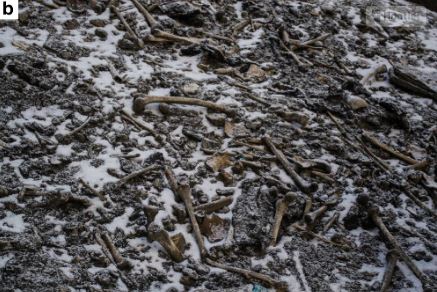It's also home to the skeletal remains of several hundred individuals of unknown origin and that led to a lot of speculation about how it came to be. Were they part of a massacre or sacrifice? A cataclysmic event?
No, people just threw bodies in the lake throughout history, according to analysis of 38 skeletons found there. One group of 23 individuals have ancestry that falls within the range of variation of present-day South Asians, while 14 have ancestry typical of the eastern Mediterranean and one individual with Southeast Asian-related ancestry.

Image of disarticulated skeletal elements scattered around the Roopkund Lake site. Photo by Himadri Sinha Roy.
Radiocarbon dating showed all of the individuals with South Asian-related ancestry date to 800 AD, but not all at the same time, while all other individuals date to just 200 years ago. Also interesting are that stable isotope measurements reveal a distinct dietary profile for the two main groups.
Citation: Éadaoin Harney, Ayushi Nayak, Nick Patterson, Pramod Joglekar, Veena Mushrif-Tripathy, Swapan Mallick, Nadin Rohland, Jakob Sedig, Nicole Adamski, Rebecca Bernardos, Nasreen Broomandkhoshbacht, Brendan J. Culleton, Matthew Ferry, Thomas K. Harper, Megan Michel, Jonas Oppenheimer, Kristin Stewardson, Zhao Zhang, Harashawaradhana, Maanwendra Singh Bartwal, Sachin Kumar, Subhash Chandra Diyundi, Patrick Roberts, Nicole Boivin, Douglas J. Kennett, Kumarasamy Thangaraj, David Reich&Niraj Rai, 'Ancient DNA from the skeletons of Roopkund Lake reveals Mediterranean migrants in India', Nature Communications volume 10, Article number: 3670 (2019)



Comments